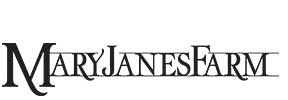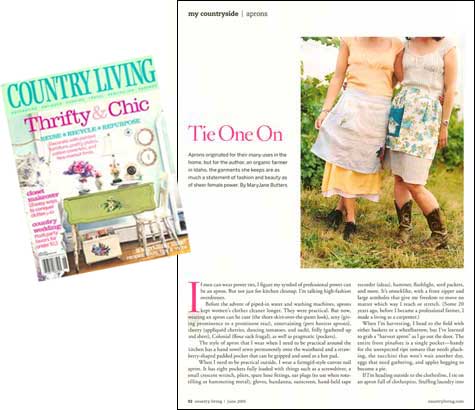Tie One On Country Living, June 2005 If men can wear power ties, I figure my symbol of professional power can be an apron. But not just for kitchen cleanup. I’m talking high-fashion overdresses. Before the advent of piped-in-water and washing machines, aprons kept women’s clothes cleaner longer. They were practical. But now, wearing an apron can be cute (the short-skirt-over-the-pants look), sexy (giving prominence to a prominent rear), entertaining (pert hostess aprons), cheery (appliquéd cherries, dancing tomatoes and such), frilly (gathered up and sheer), Colonial (flour sack frugal), as well as pragmatic (pockets). The style of apron that I wear when I need to be practical around the kitchen has a hand towel sewn permanently onto the waistband and a strawberry-shaped padded pocket that can be gripped and used as a hot pad. When I need to be practical outside, I wear a farmgirl-style canvas nail apron. It has eight pockets fully loaded with things like a screwdriver, a small crescent wrench, pliers, spare hose fittings, ear plugs (to use when rototilling or hammering metal), gloves, bandanna, sunscreen, hand-held tape recorder (ideas), hammer, flashlight, seed packets, and more. It’s smock-like, with a front zipper and large armholes that give me freedom to move no matter which way I reach or stretch. (Some twenty years ago, before I became a professional farmer, I made a living as a carpenter.) When I’m harvesting, I head to the field with either baskets or a wheelbarrow, but I’ve learned to grab a “harvest apron” as I go out the door. The entire front pinafore is a single pocket—handy for the unexpected ripe tomato that needs plucking, the zucchini that won’t wait another day, eggs that need gathering, and apples begging to become a pie. If I’m heading outside to the clothesline, I tie on an apron full of clothespins. Stuffing laundry into a dryer doesn’t resurrect me like the work of bend, lift, snap, and pin outside in fresh air. Maybe it’s the sky and wind and lack of gravity. In fact, I don’t even own a clothes dryer. Displaying my garments outside along a taut line, like Tibetan prayer flags, even in winter, is a cleaning chore that knits me all together again, unlike anything else. No wonder political flags snapping in the wind can unite an entire nation. For general everyday cleanup, I choose from several simple, full-bodied aprons that have small pockets; good for a hankie or the occasional biscuit, bit of cheese, or maybe a candy or two. Without lace or rickrack (semi-fancy), they speak utility and comfort. My favorites are well-worn. Their patina and familiarity speak of hard work and a job well done.
Even my brooms and fly swatters have homemade aprons. Fly swatters work best if you keep them handy, but who wants to look at a used fly swatter hanging on the wall? My fly swatter apron is designed so that the apron falls back against your hand when you lift the fly swatter into action, dropping down again and hiding the used swatter as soon as it’s hung back up. And while a broom apron dresses up a broom when it’s at rest, it’s an aproned broom at work that brings out the dance in me. With the addition of some music-while-you-work, sweeping becomes ballet, with the occasional plie or pirouette. And a bit of Motown lets my backbone slip, while Irish tunes get my broom and me allemanding and do-se doe-ing left and right and Latin music gets me doing the hip thing with some pelvic swivels. Who needs a dance partner when you have a graceful ballroom-dancing broom? For my mother and the women in my large extended family, aprons served another practical purpose—a place to practice one’s dressmaking skills. That’s one of the reasons I collect vintage aprons. They come in every style of stitch and fabric imaginable. The domestic apron was a symbol of pride in a woman’s handiwork talents and her homemaking role. But a go-to-town apron? I consider a dress-up town apron a statement that says, “Hey, I’m having fun.” Wearing an apron to town is the pinnacle of farmgirl style. It makes people smile. I’m big on cherries—cherry-covered aprons, cherry scarves, even cherry earrings as big as iced-tea coasters. So if I’m expecting company, my favorite apron for entertaining is a cheery cherry print with a ruffled red kick-pleat across the bottom. I add panache to my outfit with some “company’s coming” red fingernail polish. I like the ’50s look of short, red nails. They match my apron perfectly. For parades, I stand and wave from the sunroof of my 1983 Mercedes-Benz wearing an apron that matches my car, painted bright pink by my son, an auto mechanic. My yellow hat is decorated to resemble the mustard plants I grow for fuel instead of buying petroleum. The sign on the side says, “Powered by Home-Grown Fuel.” Wearing a crocheted apron reflects my sense of nostalgia for the simple life—life less busy, more ceremonial. Taking sometimes hundreds of hours to create, a crocheted apron is, in effect, just for show. A crocheted apron, with its elegant decoration, is a good way to honor all the hard work required, a way for me to hold on to all the aproned women who’ve gone before me. Or for my own here-and-now vanity, impractical little cocktail aprons or organdy hostess aprons put me on display. High heels and fancy desserts go well with these types of aprons. Now that I have a big selection of aprons, I can match what I’m wearing to my dessert colors or I can easily promote a holiday theme with appropriate hues. Colorful apparel choices are one of the reasons I collect and make aprons. More important, I wear aprons because they say glamour. Being a farmer is all about dirt. And people expect me to dress the part. Showing up in a ruffled rickracked, embroidered apron gussies up the grit my profession requires. And I consider even my daintiest of aprons a symbol of female power. MaryJane Butters lives on and works a 50-acre farm near Moscow, Idaho. In addition to publishing a magazine (MaryJanesFarm) and producing a line of 60 organic prepared foods, she has completed a book, MaryJane’s Ideabook, Cookbook, Lifebook for the Farmgirl in All of Us (Clarkson Potter; 2005). MaryJane is a leading advocate for natural living. |



